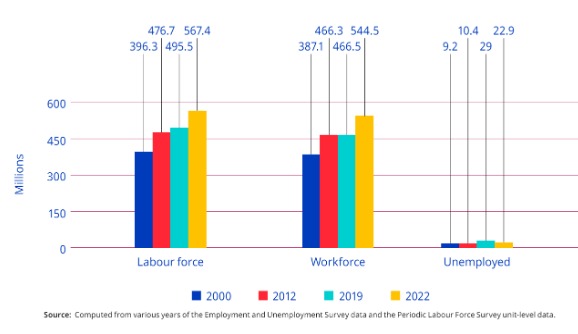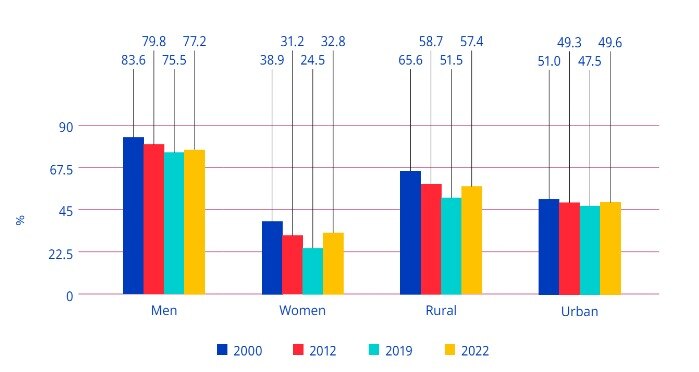Introduction
According to Forbes India, India is ranked fifth in the world’s GDP rankings in 2024 and aims to become a $5 trillion economy. But in this economy, there will be no jobs for you.
unemployment has become the biggest issue in the country today.
Joblessness is particularly high among India’s youth, with those aged 15 to 29 making up a staggering 83% of all unemployed people in India, according to the “India Employment Report 2024,” published last month by the International Labour Organisation (ILO) and the Institute of Human Development (IHD).1 out of 3 youths in the country are unemployed, Education levels have improved considerably and is a key determinant of accessing better jobs. At the same time, educated youth have higher rates of unemployment, reflecting a mismatch between their aspirations and available jobs.

Vulnerable groups of unemployment :
Youth
Employment conditions are quite adverse for the youth. The 15-24 year age group has low labour participation. Between 2016-17 and 2021-22, while the average was 42.6 percent, the LPR for the youth was much lower at 22.7 percent. Yet, the youth face a much higher unemployment rate. While the overall unemployment rate averaged 7 per cent, the youth experienced an unemployment rate of over 34 percent.
In 2022, the unemployment rate among youths was six times greater than among persons with a secondary or higher level of education (at 18.4 per cent) and nine times greater among graduates (at 29.1 per cent) than for persons who cannot read and write (at 3.4 per cent).
Youth employment is, by and large, of poorer quality than employment for adults. Employed youths have been much more likely to be in more vulnerable occupations (informal) or the informal sector. Youth wages and earnings have increased with age but are lower than what they are for adults for all categories of employment. There has been only a marginal gap between youth earnings from wage employment and self-employment, indicating poor conditions of work.
Women
Around the world, finding a job is much tougher for women than it is for men. When women are employed, they tend to work in low-quality jobs in vulnerable conditions, and there is little improvement forecast shortly. A national unemployment crisis is one reason for the gap, but entrenched cultural beliefs see women as the primary caregivers and stigmatise them for working outside the home.
Women regularly sacrifice wages, career progression, and education opportunities to meet family responsibilities, safety considerations, and other restrictions. In this context, the COVID-19 pandemic has come as a shock, resulting in massive job losses for women, especially informal workers, and slower recovery of women-led micro-businesses. It has also increased domestic work, deepened gender digital divides, disrupted girls’ schooling and placed millions of female health workers at risk.
Women’s labour force participation rate is very low, at around 25 per cent of the total female working-age population in 2022. It increased during the pandemic, driven by a significant decrease in subsistence unemployment. India has one of the lowest female labour force participation rates in the world, which is a reflection of its considerable gender inequalities.

How unemployment has caused over centuries?
JOBLESS GROWTH: In India, since independence, the rate of growth of employment has been considerably less than the rate of economic growth. Moreover, the rate of economic growth has not been adequate to absorb the increasing labour force in India
TECHNOLOGICAL ADVANCEMENT: Technological unemployment refers to the loss of jobs caused by technical change. According to the World Bank, automation threatens 69 per cent of the jobs in India, and 77 per cent in China.
POPULATION: The constant increase in population has been a grave problem in India. It is one of the main causes of unemployment. The number of unemployed persons has increased instead of decreasing during the plan period.
LACK OF SKILLS: In India, vocational skill development courses that are compatible with the Indian industry are comparatively fewer in number. A study reveals that 33% of educated youth in India are unemployed due to a lack of future skills.
LABOUR MARKET INEQUALITIES: The labour market exhibits rather high levels of inequality in terms of regions, social groups, gender and occupation. This is a major factor behind the labour market inequalities and overall societal inequalities.
Impact of unemployment :
POVERTY: The problem of unemployment gives rise to the problem of poverty.
CRIMES: People unemployed for a long time may indulge in illegal and wrong activities to earn money which increases crime in the country.
POOR ECONOMY: Unemployment affects the economy of the country as the workforce that could have been gainfully employed to generate resources actually gets dependent on the remaining working population, thus escalating socio-economic costs for the state. For instance, a 1 % increase in unemployment reduces the GDP by 2 %.
LOSS OF HUMAN RESOURCES: It is often seen that unemployed people end up getting addicted to drugs and alcohol or attempt suicide, leading to losses to the human resources of the country
What can be done by the government to increase unemployment?
- Make production and growth more employment-intensive. the country needs to have a high rate of growth but also an employment-intensive process of growth. Support the emerging employment-generating modern manufacturing and services sectors
- Systems for skills training and active labour market policies are more effective. Skills training and ALMPs are crucial for bridging the supply-demand gaps and improving employability.
- Improve the quality of jobs by investing in and regulating sectors that are likely to be an important source of employment for young people, such as the care sector, digital economy, etc. Create an inclusive urbanization and migration policy. India is likely to experience a higher rate of urbanization and migration in the future as more and more youths aspire to seek decent xxvi X India Employment Report 2024: Youth employment, education and skills employment, which would be available mostly in urban areas.
- Secure a strong supportive role of labour policy and labour regulation by Overcoming labour market inequalities. The creation of good-quality employment needs to be supplemented by measures that reduce the stark inequalities in the labour market. states. This is very important, given the broad differences across regions and states in the labour market outcomes and the potential demographic dividend.
Conclusion:
Unemployment or severance is a severe social and profitable problem that has far-reaching consequences across the board, but it’s occasionally disregarded. To better understand the causes of unemployment and how to solve them, a more robust method of assessing unemployment should be implemented.
India needs to make dedicated efforts in order to decrease the number of unemployed people. By following a comprehensive approach including skilling of people, better education, increased focus on labour-intensive sectors, etc. India will be able to decrease the unemployment rate substantially.
-BHAWNA SINGH
MUST READ: WILL THE CONFLICT BETWEEN IRAN AND ISRAEL GIVE RISE TO WORLD WAR 3?





